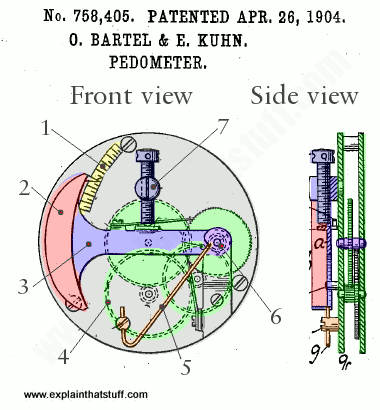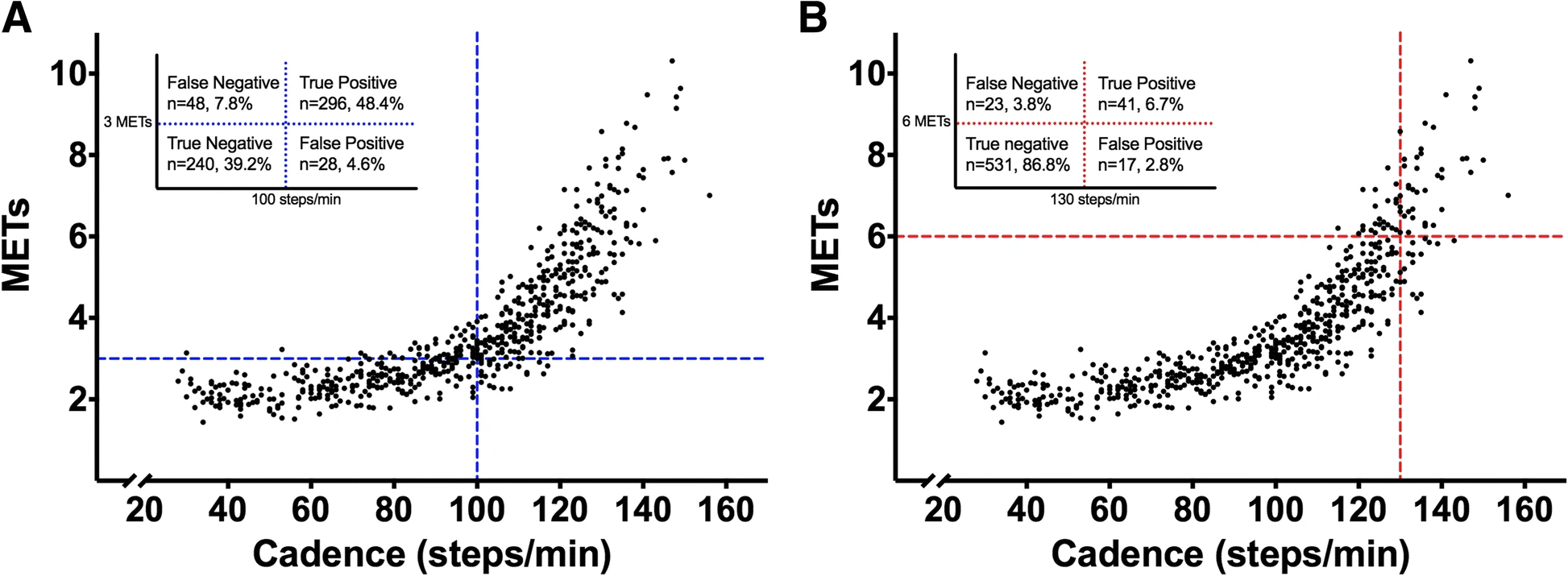Energy of movement
Metabolic and Mechanical Energy measurement
Metabolic power is estimated from oxygen consumption based on the energy being released from food. Burning 1 cm$^3$ of $O^2$ releases about 20 Joules of energy.
Mechanical power is measured as the power delivered by the human (or animal). For example using a bicycle ergometer.
Metabolic power is approx 4 x mechanical power (an estimate of the efficiency of the human machine)
- Human peak mechanical power is about 1400 watts (measured on an ergometer with both hand and foot pedals.)
- Human powered flight requires ~250 watts (e.g. Gossamer Albatross)
Measuring metabolic power via changes in $O_2$ consumed or $CO_2$ produced.
V02 is a volumetric measurement relating metabolic energy to the consumed oxygen
- Typically done on a bicycle ergometer or a treadmill.
- Allows O2 consumption to be estimated of concentration in inspired and expired air.


 Left:Oxygen consumption vs Mechanical power on a bicycle ergometer. Right: Schematic of a bicycle ergometer.
Left:Oxygen consumption vs Mechanical power on a bicycle ergometer. Right: Schematic of a bicycle ergometer.
quiz: How would you calculate the power produced by a person on a bicycle ergometer given knowledge of the persons cadence (cycles per minute) and the forces in the belts/cables ($l$ in the picture figure 3)


 Left: Mechanical power that an athlete on a bicycle ergometer was able to sustain (from D.R. Wilkie (1985) J. exp Biol. 115 1-13) Right: Metabolic power extrapolated for world record speeds (1986) over 5-10km (based on Prampero (1986) Int. J. Sports Med. 7 55-72)
Left: Mechanical power that an athlete on a bicycle ergometer was able to sustain (from D.R. Wilkie (1985) J. exp Biol. 115 1-13) Right: Metabolic power extrapolated for world record speeds (1986) over 5-10km (based on Prampero (1986) Int. J. Sports Med. 7 55-72)
Notes
- muscles have an optimal performance region.
- Power extraction requires a cyclic action.
Factors that effect power include
- Person's level of fitness
- Level of fatigue
- Posture,
- Nature of the force-velocity cycle – eg rowing vs cycling
| Number of subjects | Mean mass | Mean max power | ||
| Kg | W (W/Kg) | |||
| Male | Sprinters | 10* | 72 | 1221 (17.1) |
| rugby forwards | 17 | 91 | 1221 (13.3) | |
| hockey players | 12* | 68 | 1011 (14.8) | |
| endurance runners | 12 | 64 | 758 (11.7) | |
| recreational | 7 | 65 | 813 (12.4) | |
| Women | sprinters | 56 | 793 (14.1) | |
| recreational | 7 | 59 | 594 (10.2) |
Maximum power output in bursts of about six seconds on a bicycle ergometer from the data of H. Vandewalle et al. (1987) Eur J. appl. physiol. 56 650-656 From R McNeill-Alexander The human machine - Groups marked * were mostly or all members of the French national team
Further research
Look up the work of Eadweard Muybridge (e.g. (http://www.artsmia.org/animal-locomotion/) ) also lookup Harold Edgerton who worked at MIT in the middle of the last century.
Inertial measurements, Pedometers, and Activity monitors
(https://actigraph.desk.com/customer/en/portal/articles/2515580-what-are-counts-) counts (https://actigraph.desk.com/customer/en/portal/articles/2515804-what-is-the-difference-among-the-met-algorithms-) MET (https://actigraph.desk.com/customer/en/portal/articles/2515835-what-is-the-difference-among-the-energy-expenditure-algorithms-) Energy expenditure (https://en.wikipedia.org/wiki/Basal_metabolic_rate)Modern activity monitors are based in part on mechanical pedometers. A lever was used as a mass-spring-damper mechanism. This in turn connects to a cycle counter.
Key to figure t.b.d. (fig:ped)
- Spring adjustment scale?
- Weight is red
- Lever
- Gear train
- Spring
 Mechanical Pedometer patent- see (http://explainthatstuff.com) and US Patent 758405 (1904 Gustav Bunzl)
Mechanical Pedometer patent- see (http://explainthatstuff.com) and US Patent 758405 (1904 Gustav Bunzl)
Modern pedometers and fitness bands replace the mass-lever mechanism with an accelerometer[king2016application] and[zhao10:_full_featur_pedom_desig_realiz]. This means that there is no longer a resonant frequency that can be tuned to the cadence of walking.
Manufacturers do not publish details of their algorithms, but it appears that algorithms either try to simulate individual step counts as per the original mechanical pedometers, or band pass filter the data at about 0.75 Hz (possibly with a bandwidth of 2-4Hz), threshold filter output and summate over a 30 second or 1 minute epoch. This appears to amount to about 35-40 counts per step (heel strike to heel strike). (see (https://actigraph.desk.com/customer/en/portal/articles/2515580-what-are-counts-) for details such as they exist.
A rough estimate of energy can be made by averaging the vertical acceleration while walking, and using this to estimate the change in potential energy of the persons centre of mass.
Metabolic Equivalent of Task
Metabolic equivalent of task (MET) is an imprecise definition where 1 MET is the metabolic energy per kilogram used when a person is resting. Wikipedia ((https://en.wikipedia.org/wiki/Metabolic_equivalent_of_task)) has a good summary of the various definitions.
The MET is calculated from counts, that is the output of a band-pass filter with a mid point of about .75 Hz, that is thresholded and summed over a minute, roughly corresponding to steps per minute.
| Freedson Adult (1998) | |
| Freedson Treadmill Adult (1998) | MET Rate = 1.439008 + (0.000795 * CPM) |
| Crouter Adult (2010) | |
| Hendelman Adult Overground (2000) | MET Rate = 1.602 + (0.000638 * CPM) |
| Hendelman Adult Overground and Lifestyle (2000) | MET Rate = 2.922 + (0.000409 * CPM) |
| Swartz Adult Overground and Lifestyle (2000) | MET Rate = 2.606 + (0.0006863 * CPM) |
| Leenders Adult Treadmill (2003) | MET Rate = 2.240 + (0.0006 * CPM) |
| Yngve Adult Treadmill (2003) | MET Rate = 0.751 + (0.0008198 * CPM) |
| Yngve Adult Overground (2003) | MET Rate = 0.751 + (0.0008198 * CPM) |
| Brooks Adult Overground (2005) | MET Rate = 2.32 + (0.000389 * CPM) |
| Brooks Adult Body Mass \& Overground (2005) | MET Rate = 3.33 + (0.000370 * CPM) - (0.012 * BM) |
| Freedson Children (2005) | MET Rate = 2.757 + (0.0015 * CPM) - (0.08957 * Age) - (0.000038 * CPM * Age) |
- CPM=Counts per minute
- Age = age in years
- BM=Body Mass in kg
Mortazavari[mortazavi2013met] estimates that errors in measurement of up to 80% in MET calculations using step counts computed from accelerometers
Walking cadence, Tudor-Locke et al.
Walking cadence and exercise intensity[tudor2019walking].
Study of 76 healthy adults (10 men and 10 women representing each 5-year age-group category between 21 and 40 years)
- 5-min treadmill bouts at differing speeds
- Measured walking cadence and MET
Paper looking for the relationship between cadence (stepcount) and metabolic energy costs, i.e. using steps to predict energy.
 Using cadence as a simple classifier for MET levels (Tudor-Locke Figure 2)
Using cadence as a simple classifier for MET levels (Tudor-Locke Figure 2)
x.x

 Recalculation of Tudor-Locke's data. Left fig: Effect of obesity (red dots). Right fig: Energy efficiency curves. Blue dots males, red dots females.
Recalculation of Tudor-Locke's data. Left fig: Effect of obesity (red dots). Right fig: Energy efficiency curves. Blue dots males, red dots females.
Discussion, and criticisms?
Thoughts about
- validity of the classifier.
- translation to Fitbit etc
10/10/2023